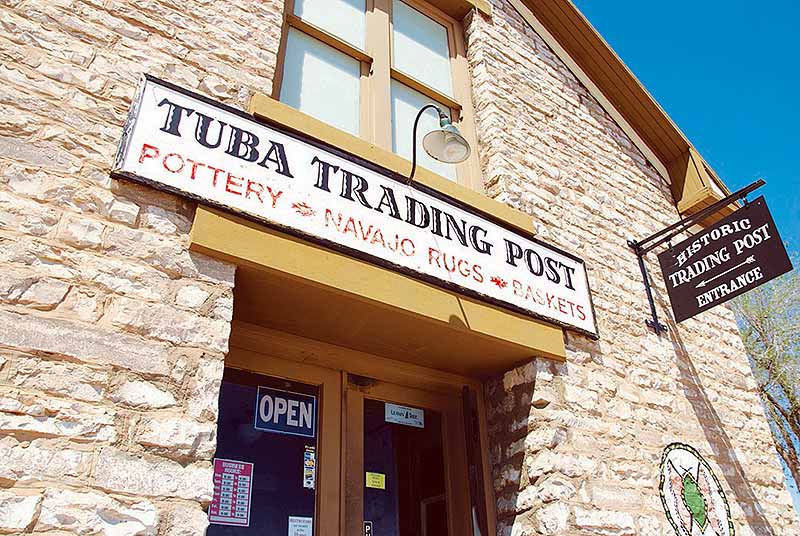
50 Years Ago: Trading post burglaries common, too many people riding in back of pick-up trucks

Tuba City Trading Post in Tónaneesdizí is flavored more by the early twentieth century than today. Seventy-five percent of its customers are non-Native and 25 percent are Native. The decades old trading post carries arts and crafts, books, clothing, kachina dolls, Navajo jewelry and rugs, as well as other items. (Times photo – Krista Allen)
This was a big week for Hubbell Trading Post in Ganado.
On August 16, 1965, the U.S. Senate passed a resolution establishing the trading post as a national historic site.
The trading post was started by Don Lorenzo Hubbell in the 1870s and his family operated it for more than 90 years before allowing the National Park service to buy it.
In documents listed in the senate resolution, the cost of acquiring the post itself, as well as the land it sits on and other buildings was estimated at $169,000. The government had agreed to pay anther $143,000 to purchase the post’s collection of pictures and other artifacts relating tot he early days of the West.
Government officials said they planned to spend another $635,000 to develop the park as a tourist site by running the post the same way that the Hubbell’s did during their days.
Since then, more than a million tourists have visited the site, according to the National Park Service. Speaking of trading post, a “major burglary” occurred this week at the Fort Wingate Trading Post that got city, county, state and federal authorities involved in the investigation.
The interesting part about the burglary is that everyone thinks that it was a professional job because whoever did it blew open a wall safe at the trading post, collecting some $2,200 in cash.
While robberies at trading posts in and around the Navajo reservation were a common occurrence, happening every two months or so, past robberies consisted of someone, usually in a mask, holding up the clerk in the store, making away with a couple of hundred dollars from the store’s cash drawer.
The Fort Wingate job, however, appears to have been executed at a time when no one was there and at a time when the store would have the maximum amount in the safe.
Some of the Indian arts and crafts were also taken but management at the trading post said an inventory will have to be done to determine exactly how much is missing.
Back in the 1960s and 1970s, it wasn’t uncommon to see people riding in the back of pick-up trucks even though everyone agreed that it was probably the worst place to be if an accident occurs.
Still, dozens of people, including some children, died annually on reservation roads just because they were riding in the pick-up bed and were thrown out when the pickup overturned or hit some other object, such as another vehicle.
In late August, the practice claimed the life of a former Navajo police officer from Crownpoint, Tony Becenti, when he fell from the bed of the pick-up into the path of another vehicle.
In this case, Becenti, 33, fell off the pickup when the pickup struck a bump in the road, causing him to fall off the truck.
And finally, a name that was familiar to readers of the Navajo Times was back in the news.
Chet MacRorie, who was publisher of the paper from 1961 to 1964, was hired by the Gallup Independent in late August 1965 to be the paper’s advertising director.
Before he had been publisher of the Navajo Times, MacRorie had been the publisher of the Gallup Independent for three years in the 1950s.
The owner of the Independent, John Zollinger, said he was happy to get someone of MacRorie’s background working for him and MacRorie, who had worked in area newspapers since leaving the Times, said he was glad to be able to move back to Gallup.
MacRorie would eventually come back tot he Navajo Times as general manager in the early 1970s after Peter MacDonald replaced Raymond Nakai as tribal chairman and after leaving the Times for the second time, MacRorie would start his own advertising firm in Gallup.
In later interviews, MacRorie said coming back to Gallup was bittersweet since he still had ill feelings toward Nakai and how he was treated when he worked for the Times.
Still, he said, he was interested in seeing how the paper continued to try and cover the news, despite efforts by people in the Navajo Tribal Council or in the Nakai administration to control what was printed in the tribal newspaper.
To read the full article, pick up your copy of the Navajo Times at your nearest newsstand Thursday mornings!
Are you a digital subscriber? Read the most recent three weeks of stories by logging in to your online account.








 Highway 264,
Highway 264, I-40, WB @ Winslow
I-40, WB @ Winslow